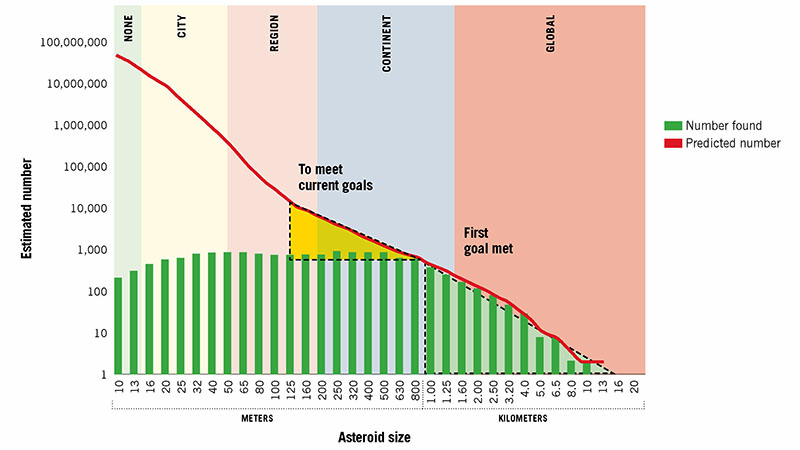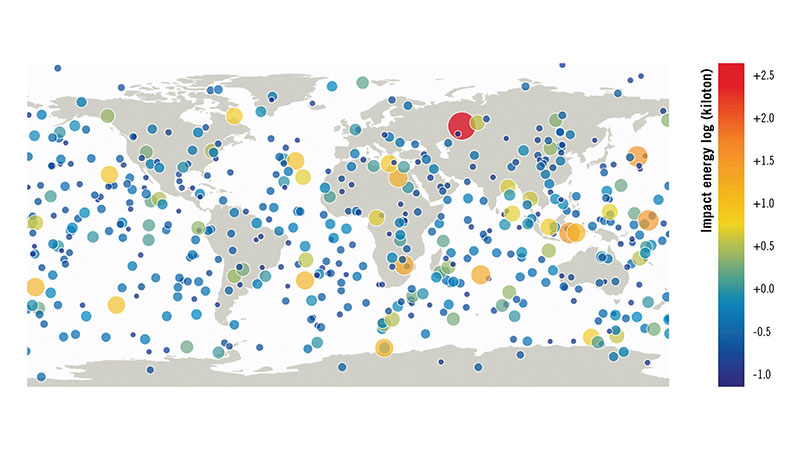Stay Up to Date
Submit your email address to receive the latest industry and Aerospace America news.
Examining the effectiveness of the new U.S. preparedness strategy
The physical shock waves from the half-megaton asteroid explosion that echoed over the Russian city of Chelyabinsk sent 1,500 people to the hospital (luckily, none of their injuries was serious), but the detonation also shook governments and space agencies around the globe. Chelyabinsk was just a sample of the destructive potential of the impact of an asteroid larger than that 20-meter body.
The U.S. laid out a logical road map for asteroid and comet defense and emergency response in the “National Near-Earth Object Preparedness Strategy” released in the waning days of the Obama administration.
The strategy was the product of an interagency working group that built on earlier discussions and exercises conducted by NASA and the Federal Emergency Management Agency. The 19-page national strategy sets out the U.S. approach to preventing an asteroid disaster; an “action plan” to implement the strategy will follow.
The new administration should adopt this sensible strategy and move rapidly to implement its detection and deflection objectives.
“We are waiting for the new administration to get its feet on the ground … and learn who we’ll be working with to take this forward,” says Lindley Johnson, NASA’s planetary defense coordination officer, in a phone interview. “I suspect that will take a few months — not too long. … We hope to work on the action plan by mid-2017.”
Asteroid impetus
On Feb. 15, 2013, the Chelyabinsk asteroid shattered in the atmosphere 30 kilometers above the city, releasing light, heat and blast energy equivalent to about 30 of the atomic bombs that ended World War II. But the 12,000-metric-ton asteroid, which arrived undetected by ground-based telescopes, was just the largest recent example of the steady rain of asteroid and comet fragments that strikes Earth. A Chelyabinsk-size impact can be expected every 20 to 40 years; a 40-meter object, like the one that struck the Tunguska region in Siberia in 1908, collides with our planet once or twice a millennium. Tunguska generated a 5-megaton blast that flattened 2,000 square kilometers of forest, an area equivalent to two-thirds of the state of Rhode Island.
Fireball data from U.S. infrared sensors on a constellation of geosynchronous and highly elliptical orbit satellites show that small asteroids and comet fragments routinely strike Earth; it’s just a matter of time before another large impact occurs. As of late January, NASA’s NEO search program had cataloged nearly 16,000 objects; none at present has a high probability of hitting Earth.
But there’s no shelter in statistics: The NEO population comprises an estimated 13,000 objects 140 meters and larger, each capable of releasing more than 60 megatons of energy. Of these, only an estimated 28 percent have been found. There are thought to be 300,000 Tunguska-size objects (40 meters and larger), while about 10 million objects exceed the diameter of the 20-meter Chelyabinsk asteroid.
The good news is that Earth is a small target: a 140-meter NEO impact occurs only every 20,000 years or so. Still, a couple of factors encouraged the U.S. to circulate a policy enabling timely detection and impact prediction, moving toward a demonstrated asteroid deflection capability. First, there’s the potential for damage from a megaton-scale asteroid explosion in the atmosphere every couple of decades. Second, early detection of asteroids and timely impact predictions, coupled with effective communication of that information across the globe, should head off the worriesome confusion of an asteroid impact with a nuclear detonation in politically unstable regions, such as North Korea or southwest Asia.
Impact prevention objectives
For over six years, NASA has had the lead role in the U.S. government for researching the NEO hazard and identifying asteroids headed our way. NASA was also a co-chair with FEMA of the 2016 interagency working group that drafted and coordinated the new strategy. The NEO policy is in line with other government disaster preparedness planning, like that anticipating a future solar storm. The U.S. NEO strategy, drawing on a decade of NASA and National Research Council reports and interagency discussions, lays out objectives for enhancing NEO impact preparedness in three areas: hazard and threat assessment, decision-making and response.
The objectives are:
- Enhance NEO detection, tracking and characterization capabilities
- Develop methods for NEO deflection and disruption
- Improve modeling, predictions and information integration
- Develop emergency procedures for NEO impact scenarios
- Establish NEO impact response and recovery procedures
- Leverage and support international cooperation
- Establish coordination and communications protocols, and thresholds for taking action
These objectives should be pursued logically and concurrently, with the more ambitious capabilities maturing after significant progress on earlier goals.
The first two objectives are the most important: NEO detection and NEO deflection capabilities. Employing an asteroid deflection capability, for example, relies on NASA’s search program finding most of the NEOs in that worrisome 140-meter-and-up range. “Finding them early” must come first; detection enables prudent technology development and mission planning, prerequisites for a practical means of asteroid deflection.
NASA’s annual $50 million NEO program budget pays for most of the ground-based telescopic search efforts, which find nearly 2,000 NEOs annually.
However, ground-based telescopes cannot complete the congressionally ordered 140-meter-object survey until well into the 2030s. Detecting small, dim and usually distant NEOs requires sensitive, rapid and repeated observations, traits more characteristic of a space-based, infrared search telescope. The NASA-funded Jet Propulsion Lab’s NEOCam space mission concept was designed to perform the NEO detection survey in less than 10 years, but earlier this year it failed to win funding from the Discovery planetary mission competition.
Despite the setback, NASA’s Johnson says: “We still believe to do [NEO search] in a timely manner, we need to move to a space-based capability, particularly with the IR.”
Finding potentially hazardous NEOs is a matter of public safety. The new Congress should allocate directed funding to design and launch such an infrared NEO survey mission. The cost? About $50 million a year (for 10 years) — about 1/386th of NASA’s 2016 budget. It’s cheap insurance.
Characterizing the threat
Near-Earth asteroids number in the millions, and no two are alike. Yet how many NEOs have we examined close up? Two.
Characterization is the natural follow-up to NEO discovery and orbit cataloging. It means determining the composition and physical characteristics of an asteroid, e.g., mineralogy, mass, dimensions, density, porosity, albedo and spin rate. Characterizing a threatening NEO could mean the difference between a successful deflection or a failed attempt, resulting in an Earth impact.
The next hard information we are likely to have about individual NEOs will come from Japan’s Hayabusa 2 mission, which will arrive at the carbonaceous asteroid Ryugu in June 2018. Also outward-bound to a NEO is NASA’s Origins, Spectral Interpretation, Resource Identification, Security, Regolith Explorer, or OSIRIS-REx, mission, slated for an August 2018 rendezvous with carbonaceous asteroid Bennu. Along with the detailed mapping in 2005 of silicate asteroid Itokawa by Japan’s Hayabusa 1, these new NEO data will give us a better handle on the kinds of targets a deflection campaign might one day confront.
The White House strategy calls for developing a quick-response robotic recon and characterization capability, designed to obtain critical composition and physical information on a threatening NEO. Build one of these craft every decade; if no impact threatens, NASA could launch it to study a NEO type we have yet to see close up.
Do the demo
A pair of the White House NEO strategy goals call for developing methods for NEO deflection and disruption, and leveraging and supporting international cooperation. An ideal way to achieve both is for NASA to fund its portion of the European Space Agency-NASA, dual-spacecraft Asteroid Impact and Deflection Assessment, known as AIDA, which aims to demonstrate the deflection of a harmless NEO in October 2022. If funding can be secured, NASA would undertake the $250 millionDouble Asteroid Redirection Test, or DART, mission. A 500-kilogram DART kinetic impactor would collide with the small moonlet of the binary asteroid Didymos at a speed of about 6 km/s. This hypervelocity bullet would change the orbital period of “Didymoon” around its parent asteroid.
The European Space Agency’s Asteroid Impact Monitor, or AIM, craft is to orbit Didymos, study the binary system, and observe DART’s collision with the moonlet. Together, these two missions would for the first time demonstrate our society’s ability to change the orbit of an asteroid.
In December 2016, ESA’s ministerial council chose to not approve AIM for full development, but managers are looking at plans for an “AIMLight” mission costing less than 160 million euros. If AIM can’t meet its 2020 launch date, DART could still impact Didymos B, using ground observations to confirm success. However, AIDA is a golden opportunity to demonstrate the international technical cooperation needed to cope with a truly threatening NEO. NASA and the European Space Agency should ensure DART and AIM fly.
The new U.S. NEO policy lays out a sensible road map for impact protection. Says NASA’s Johnson, “I think having the strategy done and available for the new administration as it comes in puts us in a good position.”
Because asteroid impacts occur so rarely, policymakers might argue that there is no hurry to complete NEO surveys and test a deflection capability. Undercutting that argument is our lack of knowledge: We don’t know the orbits of 99 percent of the near-Earth objects that could cause significant, even horrific damage to Earth. We will be struck again, and we should not bet our cities and civilization on the uninformed hope that nothing is headed our way. ★
About Tom Jones
Tom flew on four space shuttle missions, including his last flight, STS-98, in which he led three spacewalks to install the American Destiny laboratory on the International Space Station. Tom is a senior research scientist at the Florida Institute for Human and Machine Cognition.
Related Posts
Stay Up to Date
Submit your email address to receive the latest industry and Aerospace America news.






